See the exercises in this article:
Upright Row and Forward Tendu ⋅ Lateral Extension and Tendu ⋅ Front Press and Plié Heel Pop ⋅ Punch and Curtsy ⋅ Shoulder Press and Split Squat ⋅ Lateral Raise and Passé
When it comes to improving upper-body strength, many people think bigger — and heavier — is better. Full-body compound moves, such as pushups and pull-ups, as well as challenging lifts, such as bench presses and heavy rows, are key for resistance training. But they aren’t the only options for building strength and endurance in the arms, shoulders, and back.
Workouts for barre arms, or dancer arms, are gaining popularity — especially among lifting newbies and folks who are short on time or don’t have access to heavier weights or machines.
“Barre arms workouts — or as I’ve playfully coined them, ‘barrms’ — take light weights and develop our upper-body strength by relying on small isometric movements or eccentric movements paired with lower-body, ballet-inspired moves,” says Life Time personal trainer and certified barre instructor Danica Osborn, CPT.
Some people assume that this style of training delivers the long, lithe limbs of a ballerina, but that’s a misconception; the length of your bones and muscles are set. What the barre arms moniker alludes to are the dance-inspired movements that are fluid and controlled, and require coordination between the upper and lower body.
“Barre arms moves are a great way to multitask and recruit larger lower-body muscle groups and smaller upper-body muscle groups simultaneously,” says Osborn. “Combining upper- and lower-body exercises mimics real-life movement patterns, as we’re rarely isolating a muscle group in our day-to-day life. These combinations also promote coordination and can keep us mentally sharp.”
This type of training typically involves higher repetitions with lighter weights. “Barre arms exercises recruit our slow-twitch muscle fibers to promote endurance and long-lasting energy,” Osborn explains. “This isn’t the time to grab weights that are heavy.”
Many moves are done with body weight only. Still, you can add weight by holding 2- to 5-pound dumbbells or attaching wrist or ankle weights, as long as you can maintain proper form.
High-rep, low-weight training likely won’t help you build maximal strength. But it is useful for building muscular endurance, which contributes to overall stability; aerobic capacity of the muscles; and the ability to carry out repetitive, everyday tasks.
In other words, barre arms workouts aren’t designed to take the place of heavier resistance training. “I love lifting with heavy weights a few times a week and supplementing my strength training and cardio with one to two days a week of lighter weights or body-weight exercises like you might find in a barre workout,” Osborn says.
“These lighter sessions are like fine-tuning our bodies, hitting the spots we might overlook in our other training. In fact, barre exercise classes originated in the late 1950s by an injured ballerina who began using ballet-inspired movements combined with physical-therapy exercises to rehabilitate her back. So, barre exercises are a great way to promote flexibility, mobility, balance, and strength.”
The Workout
The following barre arms workout, designed by Life Time personal trainer Danica Osborn, CPT, features combos that pair upper-body strength moves with lower-body barre movements.
Do eight to 10 repetitions of each of the following combos (per side, where noted), performing the upper- and lower-body moves in each pair simultaneously. Complete two full rounds of the circuit.
Begin with only your body weight until you get the hang of the exercises. Use 2- to 5-pound weights when you’re ready to progress.
Upright Row and Forward Tendu
Perform eight to 10 repetitions per side, for a total of 16 to 20 upright rows.

Upright Row
- Hold a pair of dumbbells and extend your arms straight down, palms facing the fronts of your thighs.
- Keeping the dumbbells close to your body, with your shoulders relaxed, bend your elbows and raise the weights until your elbows reach shoulder height. Maintain a neutral neck and spine and hold your gaze in front of you.
- At the apex of the move, retract your shoulder blades subtly to draw your elbows slightly back. Avoid scrunching your shoulders up.
- Reverse the movement, lowering the weights back to the starting position.
Forward Tendu
- Begin standing tall with heels together and toes pointing out.
- Ground through your left foot and extend your right leg forward, keeping your toes pointed down. Aim to avoid raising your foot off the floor; instead, brush your foot along the floor until only your toes touch the floor.
- Reverse the movement to bring your right heel back to meet the left.
- Complete eight to 10 reps, then switch to the other side.
Lateral Extension and Tendu
Perform eight to 10 repetitions per side, for a total of 16 to 20 lateral extensions.
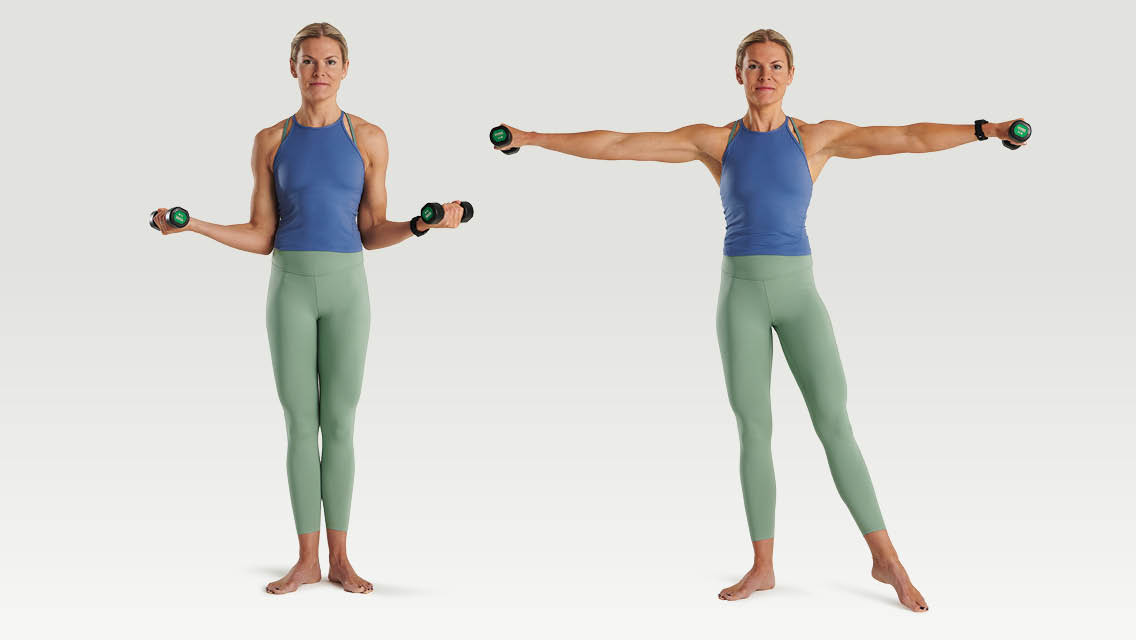
Lateral Extension
- Grasp a pair of dumbbells and bend your elbows at your sides so your hands are palm-side up.
- Extend your arms and punch the dumbbells straight to the sides, rotating the weights so your palms face the floor.
- Reverse the movement by bending your elbows and rotating the weights to return to the starting position.
Lateral Tendu
- Begin standing tall with heels together and toes pointing out.
- Ground through your left foot and extend your right leg to the right side, keeping the toes pointed down. Avoid raising your foot off the floor; instead, brush your foot along the floor until only your toes touch the floor. Avoid pointing your toes behind you or directly to the side; cheat the movement slightly forward on a diagonal.
- Reverse the movement to bring your right heel back to meet the left.
- Complete eight to 10 reps, then switch to the other side.
Front Press and Plié Heel Pop
Perform eight to 10 repetitions per side, for a total of 16 to 20 front presses.

Front Press
- Hold a pair of dumbbells and raise them to shoulder height, palms facing in.
- Extend your right arm and press the weight overhead, rotating the dumbbell so your palm faces forward. (If this is too difficult, uncomfortable, or painful, allow the dumbbell to rotate to a more neutral position as you press overhead.)
- Lower the weight to shoulder height and repeat with the left side.
- Alternate sides and coordinate the press with the same-side heel pop. (When you press your right hand overhead, raise the right heel; and vice versa.)
Plié Heel Pop
- Assume a plié squat position: feet wide and toes turned out to about 45 degrees. At the bottom of the squat, your shins will be close to perpendicular to the floor.
- While maintaining an upright posture and holding the plié squat, press through the balls of your right foot and raise your right heel as high as you can.
- Continuing to hold the plié squat, lower your right heel and lift your left heel.
- Alternate sides to complete eight to 10 reps per side. Coordinate the heel pop with the same-side press. (When you raise the right heel, press your right hand overhead; and vice versa.)
Punch and Curtsy
Perform eight to 10 repetitions per side, for a total of 16 to 20 total punches per side, per round.

Punch
- Hold a pair of dumbbells and extend both arms straight in front of you at shoulder height, palms facing down.
- Holding your left arm extended and still, punch your right arm above your left arm, then below.
- Alternate punching your right arm above and below your left. The punching arm will correspond to the back leg of the curtsy squat in this combo. (Punch with your right arm when your right leg is back, and vice versa.)
- Perform eight to 10 up-down reps for a total of 16 to 20 punches, then switch sides.
Curtsy Squat
- Assume a curtsy squat position by stepping your right foot back and to the left, allowing both knees to bend to 90 degrees.
- Fully extend both knees to straighten your legs, keeping your feet where they are. (Do not step your back foot forward.)
- Repeat, lowering your hips by bending your knees then straightening your legs. The back leg will correspond to the punching arm in this combo. (When your right leg is back, punch with your right arm, and vice versa.)
- Complete eight to 10 reps, matching the raise and lower with the punch-up and -down of the arm movement, then switch to the other side.
Shoulder Press and Split Squat
Perform eight to 10 repetitions per side, for a total of 16 to 20 presses per round.
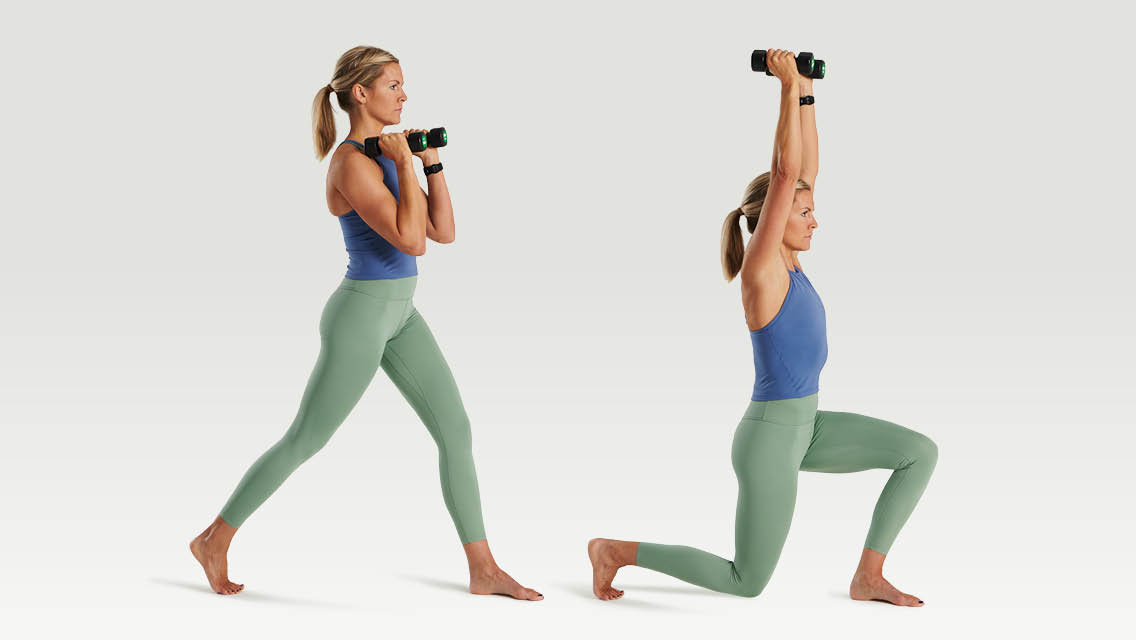
Shoulder Press
- Hold two dumbbells at shoulder height with a neutral grip, palms facing each other.
- Press both dumbbells straight overhead.
- Lower the dumbbells to the starting position and repeat.
- Complete eight to 10 repetitions. Coordinate the press with the lunge so your arms are fully extended when you assume the bottom position of the lunge.
Split Squat
- Stand with feet about hip width apart.
- Step backward with your right foot to find the top of a lunge position with both legs extended. Bend both knees and lower your hips until the knees form 90-degree angles. Extend your legs to return to the top of the lunge position, but don’t bring your feet together. (Adjust the length of your stride as needed.)
- Complete eight to 10 repetitions, pressing up with the dumbbells each time bend your knees to lower down. Switch sides and repeat.
Lateral Raise and Passé
Perform eight to 10 repetitions per side, for a total of 16 to 20 lateral raises per round.
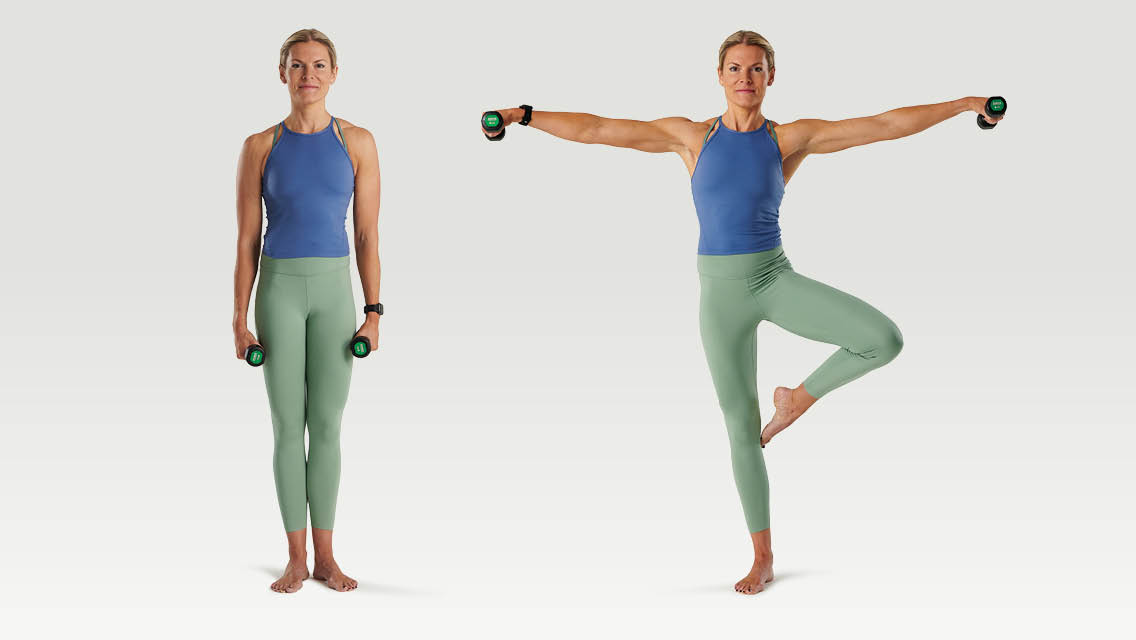
Lateral Raise
- Hold two dumbbells and stand with your arms long and at your sides, palms facing your body.
- With a slight bend in the elbows, raise the dumbbells out to your sides.
- Lift until your arms are parallel to the floor, palms facing down.
- Slowly lower the dumbbells to return to the start position.
- Complete eight to 10 repetitions, raising your arms while you raise your foot in the passé.
(Finesse your lateral raise form at “BREAK IT DOWN: The Lateral Raise.”)
Passé
- Begin standing tall with heels together and toes pointing out.
- Ground through your left foot and bend your right knee to the side to raise your pointed right foot. Tap the insides of your left knee with your right toes. (Take care not to put any pressure on the knee with your foot.)
- With control, lower your right foot to the floor.
- Complete eight to 10 repetitions, raising your foot while you raise your arms. Switch sides and repeat.
This article originally appeared as “Barre Arms” in the April 2023 issue of Experience Life.
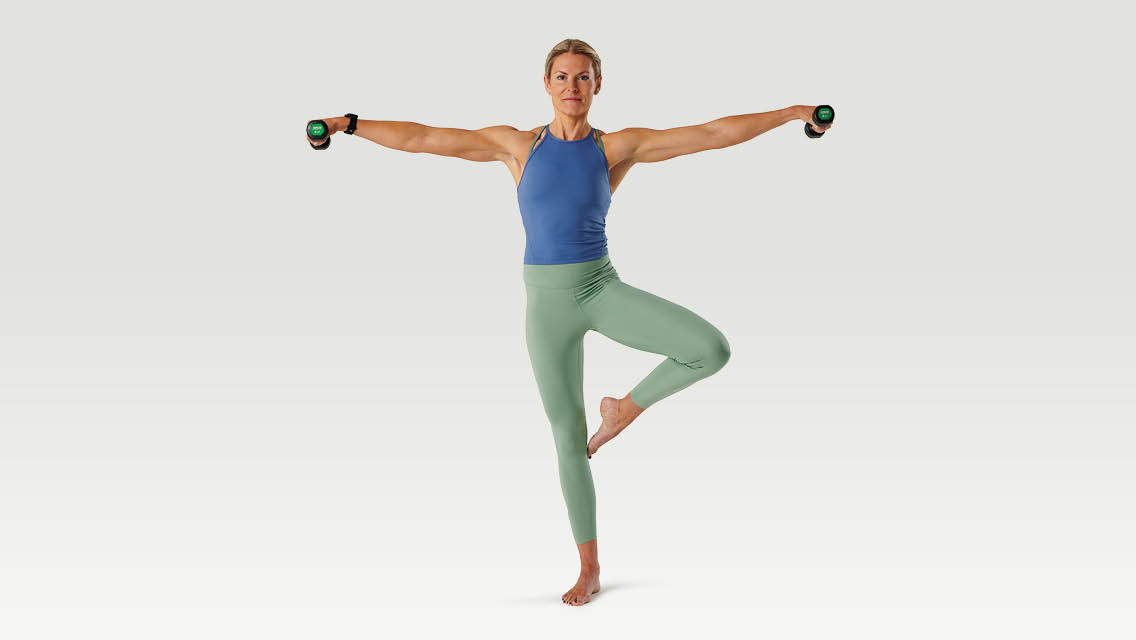

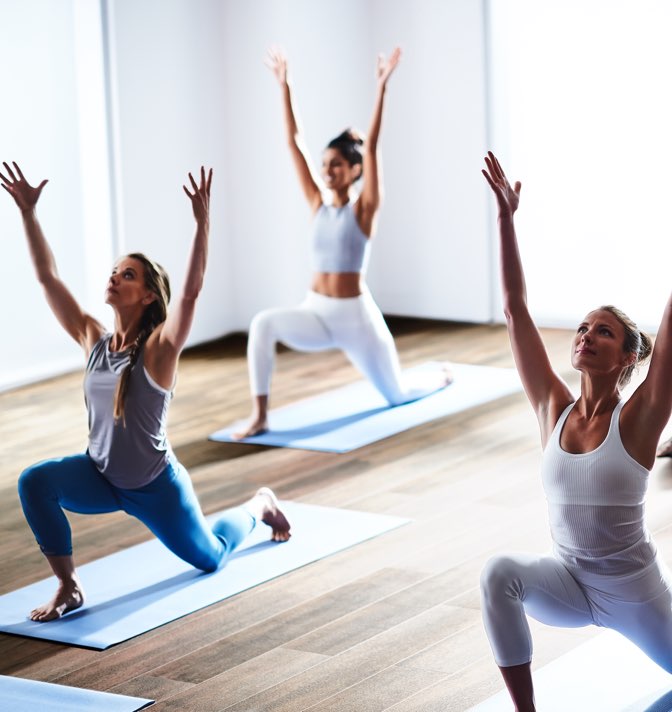
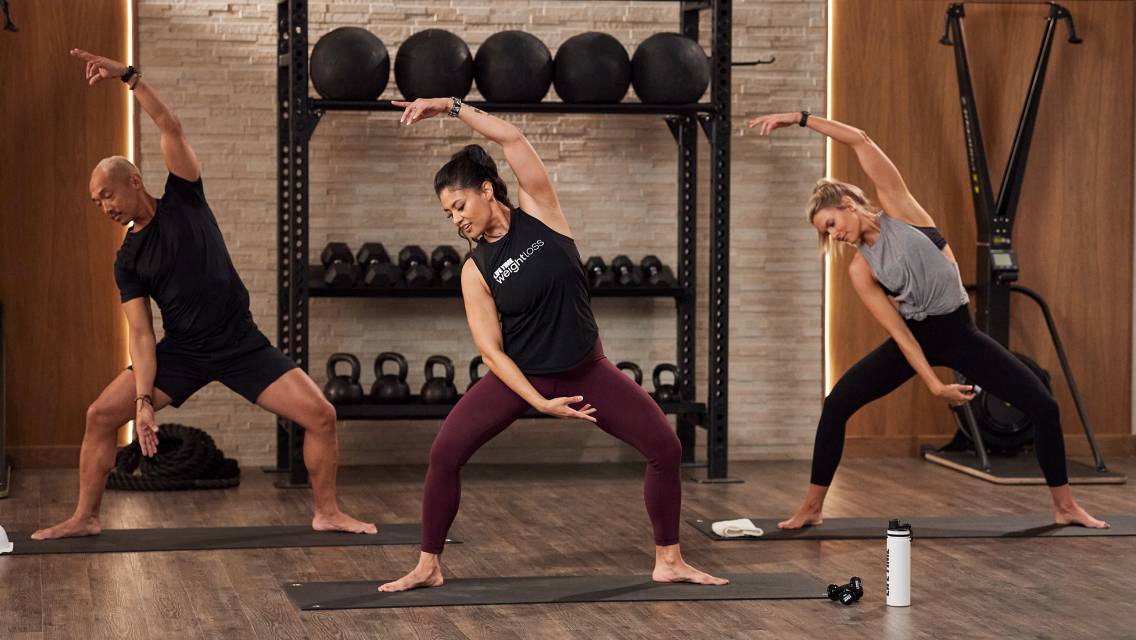
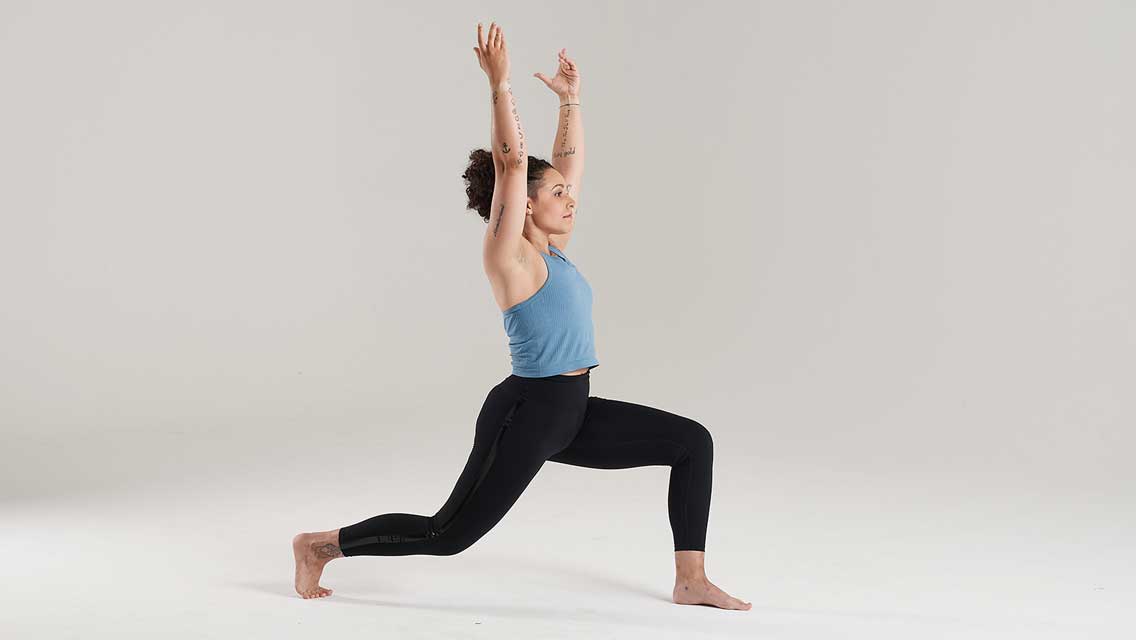

This Post Has 0 Comments